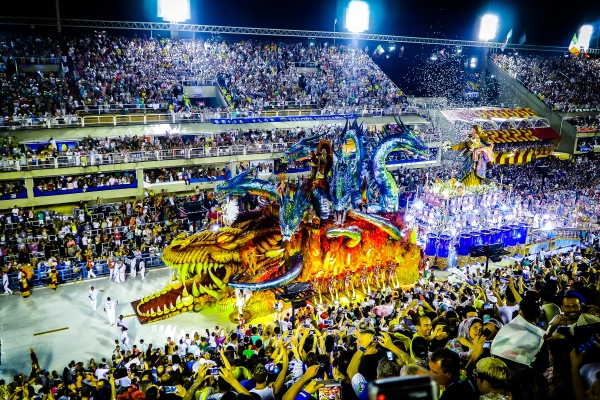While we may celebrate carnival anywhere in the world, there’s only one place that brings to mind astonishing costumes, a sparkly display of colours and lively processions marching through city streets – just before Lent the pulse of revelry is the strongest in Rio de Janeiro.
When is the Rio Carnival? How much does it cost to see the best samba schools in their glory? And are there any other events in the city apart from the battle of samba schools at the Sambadrome? As 2022 marks another year we miss out on extravagant parties, join us on a literary journey to discover the secrets of this incredible event.
Rio de Janeiro: world’s most spectacular carnival!
The carnival extravaganza isn’t limited to Rio de Janeiro – you can join parties in São Paulo, Florianopolis, Manaus or Porto Seguro. The character of the celebrations differs from city to city, with Olinda’s take on celebrations being a display of strong ties to local folklore and culture. Still, it’s the Carnival in Rio de Janeiro that remains the biggest crowd-puller. At its peak of popularity, up to 2 million tourists roamed the streets of Rio, many of them travelling thousands of kilometres to soak the atmosphere and revel in the South American celebrations.
At first glance it may seem that all rich colours, blasting music and crowds filling the streets are pretty much the same everywhere we go. While they may look the same, they definitely do not sound alike! A trained ear will immediately notice clear differences between carnival celebrations in various places in Brazil. Southern cities, such as Rio de Janeiro and São Paulo, are filled with sounds of samba and marchinha. But as we move in the northeastern direction, we hear more frevo and axé. It’s worth to keep that in mind while choosing the destination of our carnival journey!
When is the Rio Carnival?
World’s most famous carnival celebration begins on the last Friday of the carnival and lasts up until the Ash Wednesday. … or so people say officially. In reality, preparation starts much earlier and competing samba schools work all year on their shows. The symbolic handover of the keys to the city marks the beginning of the five days of everlasting party (even the subway is available 24 hours a day!). From that moment on, Rio sparkles, follows the rhythm of music and makes it hard to resist the allure of carnival celebrations. Travelling half the world to join the party, we’re bound to spend at least five magical days in Rio, but it’s worth to double-check when does the main competition take place. That’s when the most spectacular shows take place and one can see the champions do what they can do best.
There’s just one more thing – getting a ticket to enter the Sambadrome. Tickets available for Brazilian distribution can be purchased only by people assigned a special number (resembling an American social security number), while tickets in particular countries are sold by local companies. Obviously, the price heavily depends on the place on the stands; if we want the best view, we’ll have to splurge and spend as much as 300 dollars.
The stunning eclecticism of the carnival: how to celebrate the Brazilian way?
From the west side to the east, south side to the north, just before Lent Brazil follows the rhythm of carnival all day long. This astounding celebration of life wastes no time on sleep, devoting most of the energy to dancing, singing, embracing your loved ones and cultivating traditions. The Sambadrome is the centre of attention in cities such as Rio de Janeiro or São Paolo. Here everyone pulls an all-nighter to see samba schools battle it out. To many, the real beauty of the Brazilian carnival is visible on the city streets – groups known as blocos organise multiple parties on the block and on the beach. These celebrations are a wonderful display of Southern American traditions, often highlighting foreign influences.
In Rio de Janeiro and São Paolo the party revolves around spectacular shows, but it’s quite different as we move to places such as Olinda and Recife, where it’s all about celebrating in the streets and enjoying live music. They’re less extravagant and way more friendly, but here’s one thing to remember: while we can count on multi-language speaking guides helping us out in tourist sectors at the Sambadrome, parties in smaller towns aren’t as tourist-oriented. Northern states weave local folklore into the pattern of their celebrations, creating wonderful shows where a truly remarkable carnival extravaganza blends with traditional beliefs. In the southern city of Curitiba (which, interestingly, happens to be the biggest colony of Polish immigrants in Brazil) we can participate in… a zombie walk. Clearly, even Brazilian carnival is not immune to modern influences!





